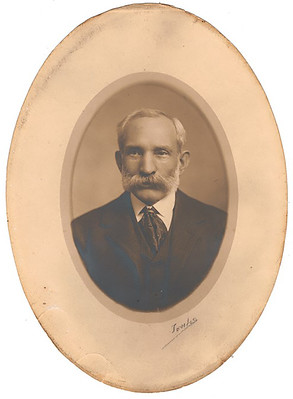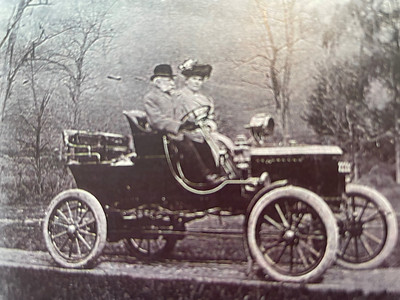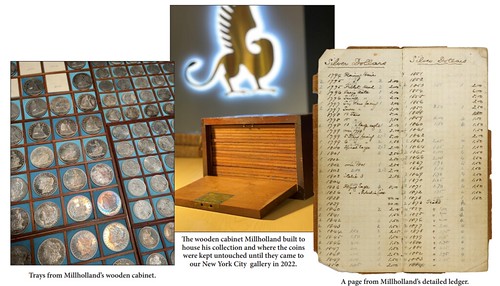
PREV ARTICLE
NEXT ARTICLE
FULL ISSUE
PREV FULL ISSUE
JAMES ALLAIRE MILLHOLLAND (1842 - 1911)Here's his family's biography of James Allaire Millholland, also republished with permission from Stack's Bowers Galleries. Thank again. An amazing and full life, well lived. -Editor
JAMES ALLAIRE MILLHOLLAND
1842 - 1911
His father, James Millholland (1812-1875), was one of the foremost railway master mechanics in the country. In 1829, as an apprentice to a prominent machinist in the B & O Railroad's shops in Reading, Pennsylvania, he helped build (supposedly of spare parts) the first light steam locomotive, the Tom Thumb, to a design of Peter Cooper's. (In the competition between this little engine and a horse pulled car, a belt slipping from a pulley resulted in victory for the horse-powered car.) Millholland, Sr. went on to design innovative locomotives, reconfigure designs, and experiment with ways to improve their propulsion.
James Allaire Millholland (JAM) continued in his father's
footsteps. Born in Reading in 1842, he received his early
education in local schools. At 17 he was apprenticed in the
shops of the Pennsylvania and Reading Railroad where he
did experimental work and gained practical experience,
including running freight and passenger engines. When
he was 24, his father relocated the family to the hills of
western Maryland. Mount Savage was uniquely located
among the ore-bearing strata of the Appalachians, as well
as serving as a gateway to the West. It teemed with industrial activity - coal, iron ore, and
clay mining; foundries; brick refractories; and machine shops
constructing locomotives. Fresh
from traveling to the Paris International Exposition in 1867
where he studied the vast number
of displays of European technological developments, JAM
set out to improve the machinery department of the Cumberland and Pennsylvania Railroad.
Within a month he became a
master mechanic of that railroad
and then an officer of the Cumberland and Pennsylvania Railroad, the Union Mining Company,
and the Consolidated Coal Company. After ten
years, he out-maneuvered hot competition
with other young railroad lines and acquired
the
JAM and his first wife, Virginia Randolph Keim Millholland (1846-1896), a descendant of the Randolphs of
Virginia, had 12 children, several of whom became mechanical and civil engineers. Their substantial house on
Washington Street in Cumberland is still standing. His first
wife died at 49, and two years later in New York, he married
Harriett Woodward Blunt, known as James A. Millholland and his wife in their 1905 Stanley Model G Light two passenger runabout – one of 11 built!
JAM wrote letters to Woodie
when he was on his frequent
business trips. Entertainingly worded and affectionately
thoughtful, they describe city
events, his experiences, even
purchases —
When James Allaire Millholland died, though retired
for four years, he was still an active director of the First
National Bank of Cumberland which honored his more
than 25 years of service, a vice president and treasurer of
Accurate Machinery Company of Cumberland, president of the Chinese Trading Company of Philadelphia,
and trustee of a hospital and a school. These associations
speak to Coda: Four years before JAM died he sold his railroad to the Western Maryland Railway Company which was soon purchased by a son of Jay Gould, known as one of the robber barons. The lives of these two Millhollands, father and son, roughly bracket the nineteenth century and trace an important era in American railroad history and its role in the industrial revolution: from an early locomotive on eight miles of track to eventual absorption of smaller local lines into larger and larger systems; regional amalgamated into nationwide; independently owned and operated burgeoning —sometimes by hook and by crook — into large complex corporately-managed entities.
To view or bid on the Millholland coins, see:
Wayne Homren, Editor The Numismatic Bibliomania Society is a non-profit organization promoting numismatic literature. See our web site at coinbooks.org. To submit items for publication in The E-Sylum, write to the Editor at this address: whomren@gmail.com To subscribe go to: https://my.binhost.com/lists/listinfo/esylum All Rights Reserved. NBS Home Page Contact the NBS webmaster 
|



